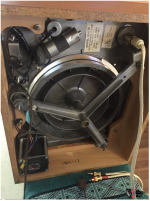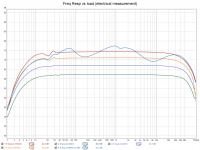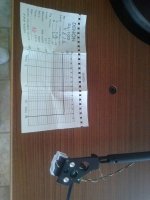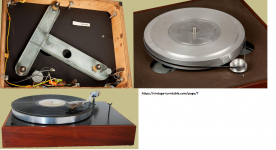I don't find lack of personal details insulting, I find ignorance resulting in attempted ridicule insulting, like yours regarding telephone engineers, and Mark's plain ignorance. You accuse others of stirring the pot when you do it all the time 🙄I believe that MM99 has answered that he is not. Your mode is tiresome, you have all sorts of opinions about others, let's hear about you.
View attachment 766478
Your lack of details is insulting to other members actually, so go ahead, fill in the blanks, let us know who you are and what your experience is, your affiliations, you have nothing to hide right ?.
Dan.
Lots of room for conjecture and guessing and assumptions.
Thank you, I knew we would agree. The way you performed your listening test with Mark leaves lots of room for conjecture, guessing and assumptions. The results are worth less than the paper this is written on.
you keep going on about level matching.....What would be your protocol for proper ‘level matching’?
Use bandwidth limited pink noise.
My question is directed at EH.I don't find lack of personal details insulting, I find ignorance resulting in attempted ridicule insulting, like yours regarding telephone engineers, and Mark's plain ignorance. You accuse others of stirring the pot when you do it all the time 🙄
You mentioned 'telephone engineer'.....do you mean EE specialising in telephony or do you mean 'subscriber maintenance engineer' visiting homes and offices and swapping out sockets and handset cords, or what ?.
Please clarify where Mark is 'plain ignorant' so that I know it when I see it in future.
Dan.
No Dan, I'm not playing games with you, all you have to do is pay more attention and you can answer your questions yourself. You've already managed to bully ToS into submission, it doesn't work with me , sorry.
Thank you, I knew we would agree. The way you performed your listening test with Mark leaves lots of room for conjecture, guessing and assumptions. The results are worth less than the paper this is written on.
Well, that is just too bad for you then.
For myself and Mark, and maybe some other, it is helpful data point to know if doing such Hf absorption and additional shielding.... can it make any detectable difference and we will continue to improve our designs and modifications and evaluate new ideas. As well as T&M and listening.
Enjoy.
THx-RNMarsh
Last edited:
For your chip based proto, I recommend trying OPA1642, namely because it has very low CM distortion in non inverting mode with high source impedances. In any xover / equalizer this is should be a benefit.
You meant: in Sallen-Key filter topology.
SJ, bullying is the exact opposite of who I am.No Dan, I'm not playing games with you, all you have to do is pay more attention and you can answer your questions yourself. You've already managed to bully ToS into submission, it doesn't work with me , sorry.
Please define 'telephone engineer' as it applies to your career.
Dan.
Interesting, I can scarcely imagine two more (visually) different turntables! Also, the Beograms that I have seen have rather stiff, low-travel suspensions. It just goes to show there are a lot of details to account for.
Yes, they are totally different in construction. Look at the underside of the Empire.
Beograms are unique. Their later suspension systems are a delicate more complex leaf & conical spring combination construction. It is low travel (restrained) and I would say with calculated stiffness. (I had a technical paper from them re their suspension but I don’t find it anymore).
Another simple and good implementation of sprung TT I’ve noticed is the CJ Walker CJ58.
All non metal (except the three under-compression springs and the platter bearing).
George
Attachments
I would use the miniDSp that I have for a first cut with better PA's. But, i measured the M2 cross-over that is stored in the Crown amps. I will make an analog version of those curves.
First cut for the analog cross-over will use opamps. Final, discrete.
Anyone: What is the most neutral/accurate opamp out there?
THx-RNMarsh
Each to their own but given how complex the curves are that George posted a while back and given you are digital only would seem a no brainer do use DSP for the crossover? Mind you the Linkwitz LX-Mini analog crossover NP designed has been very popular.
There does seem a lot of pro analog crossover bias (Even Linkwitz it has to be said) which is intriguing.
Another simple and good implementation of sprung TT I’ve noticed is the CJ Walker CJ58.
All non metal (except the three under-compression springs and the platter bearing).
George
My first turntable was a CJ58!
I haven’t been on this thread for a week or so.
It’s almost, though not quite as bad, as British politics.
😛
Peace.
It’s almost, though not quite as bad, as British politics.
😛
Peace.
you keep going on about level matching.....What would be your protocol for proper ‘level matching’?
When comparing amplifiers and loudspeakers, any single frequency test point protocol will likely lead to false conclusions if the interaction of the amplifier’s output impedance vs frequency and loudspeaker’s impedance vs frequency is not studied and taken into account.
George
Attachments
Why did you part with it Bill?My first turntable was a CJ58!
I had installed a DL-103 on this and had long listening hours at a friend’s house. I thought for a while to assassinate the owner and steal the TT.
George
Attachments
The Beogram leaf springs are an improvement over the suspending coils of the Mitch Cotter designed AR and all of its chillins playin its licks, like the Thorens TD150, Linns and such, in a really bad situation because they self center faster than vertical spring rate. But no universal optimum can be stated without defining the problem.
Much like tonearm mass x cartridge donut compliance, and their products' resonance' optimum placement between warp frequencies and signal frequencies, subchassis suspension has an optimum resonant frequency and Q to fit between structure-borne excitations (cue The Beach Boys, Good Vibrations) and the subchassis' need to couple away everything not intended to be geometrically between the record and the stylus.
Any general solutions will require that we first define our structure-borne (and even air-borne) impingements more. I say humbug - brute force works even if we don't know the details.
All good fortune,
Chris
Much like tonearm mass x cartridge donut compliance, and their products' resonance' optimum placement between warp frequencies and signal frequencies, subchassis suspension has an optimum resonant frequency and Q to fit between structure-borne excitations (cue The Beach Boys, Good Vibrations) and the subchassis' need to couple away everything not intended to be geometrically between the record and the stylus.
Any general solutions will require that we first define our structure-borne (and even air-borne) impingements more. I say humbug - brute force works even if we don't know the details.
All good fortune,
Chris
+1
Unfortunately, it will probably be some years before 'Cognitive Psychology: Biases and Heuristics,' or the equivalent becomes a required course for engineering undergraduates. Something of that nature is now taught in business schools, economics schools, the US military, and to some extent in medicine (more in the form of journal articles for medicine, last time I checked anyway).
In preparation of that, a mandatory course using something like Chalmer's "What is this thing called Science" and further readings would already help . 🙂
The Beogram leaf springs are an improvement over the suspending coils of the Mitch Cotter designed AR and all of its chillins playin its licks, like the Thorens TD150, Linns and such, in a really bad situation because they self center faster than vertical spring rate. But no universal optimum can be stated without defining the problem.

AR XA (~ 1961) was/is an exemplary engineered minimalist TT.
Good innards and well damped arm (bronze counterweight and that plastic headshell)
I think the designer was Edgar Villchur
George
Attachments
Quoted from an interview with AKM's head of audio ADC / DAC design:
"Sato: I bring a test sample to the client and ask for their opinions while listening to the test sample together. Then I convey their feedback to the engineering section or bring an engineer with me to see the client.. We talk about not only the sound but also technical matters."
Typical sales and marketing blurb, it makes the customer feel warm and fuzzy.
I would imagine that engineering specifications would be the priority rather than some non-descript subjective feedback. You can colour the audio independently of the digital and analogue conversion stages. It's the purpose of the DAC/ADC to reproduce the audio as closely as possible to the original source material with low distortion and noise.
@ vacuphile,
How could you know that?
It could be that they are correct in their agreement on the sound quality and the differences between the DUTS......
@ mountainman Bob,
That would be too much to ask.
A nice start would be to have an universally accepted set of descriptors for sound events (reproduction of sound events).
As we are using systems to evaluate recorded content or (additional/changeable) devices it would be required to have a sufficiently thoroughfull set of measurements of the specific combination.
Without standardized reproduction environements it is difficult to conclude from lab measurements to real world activity.
But if in a subjective description the meaning is widely known/accepted (and reference material available for calibration) that would be already a major step forward. (imo of course)
I've quite frequently mentioned the PEQS approach (along with links to the material, available free of charge), but aside from complaining about dither that was used or not used, the interest was quite limited so far.
Although it's intended use is for the quality assessment of recorded content, a lot could be adopted for more general purposes.
Thank you, I knew we would agree. The way you performed your listening test with Mark leaves lots of room for conjecture, guessing and assumptions. The results are worth less than the paper this is written on.
How could you know that?
It could be that they are correct in their agreement on the sound quality and the differences between the DUTS......
@ mountainman Bob,
What would be nice is if there was an universally accepted language, ie terminology, that was tied to the measurements.
That would be too much to ask.
A nice start would be to have an universally accepted set of descriptors for sound events (reproduction of sound events).
As we are using systems to evaluate recorded content or (additional/changeable) devices it would be required to have a sufficiently thoroughfull set of measurements of the specific combination.
Without standardized reproduction environements it is difficult to conclude from lab measurements to real world activity.
But if in a subjective description the meaning is widely known/accepted (and reference material available for calibration) that would be already a major step forward. (imo of course)
I've quite frequently mentioned the PEQS approach (along with links to the material, available free of charge), but aside from complaining about dither that was used or not used, the interest was quite limited so far.
Although it's intended use is for the quality assessment of recorded content, a lot could be adopted for more general purposes.
Last edited:
- Status
- Not open for further replies.
- Home
- Member Areas
- The Lounge
- John Curl's Blowtorch preamplifier part III




